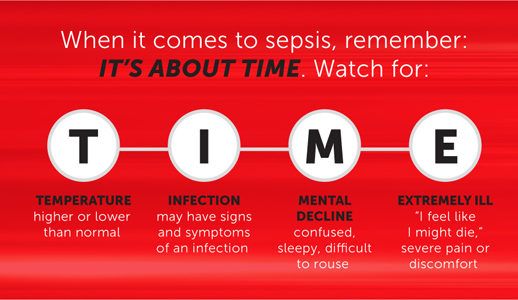
Sepsis is the body’s overwhelming and life-threatening response to infection that can lead to tissue damage, organ failure and death. The skin is the body’s largest organ and protects the body from germs and houses nerves to help detect sensations. Diabetes can affect every part of the body, including the skin.
Individuals with diabetes are at higher risk for developing sepsis than people without the disease. (Sepsis Alliance)
High blood glucose levels can increase a person’s risk of infection by:
- Pulling water from the skin, making it dry and more likely to crack. This can allow germs to enter.
- Causing blood vessels close to the skin to narrow or clog.
- Causing nerve damage over time, which affects an individual’s ability to feel wounds. This also can decrease the amount of sweat, causing dry skin.
- Lowering your ability to fend off harmful bacteria.
What can a person with diabetes do to prevent skin problems and infection?
- Keep diabetes well-managed.
- Keep skin clean and dry. Use talcum powder in areas where skin touches skin, such as the armpits and groin.
- Avoid very hot baths and showers. If the skin is dry, don’t use bubble oils. Moisturizing soaps may help. Afterward, use a standard skin lotion, but don’t put lotions between toes. Extra moisture there would help fungus grow.
- Prevent dry skin. Scratching dry or itchy skin can open it up to infection. Moisturize skin to prevent chapping, especially in cold or windy weather.
- Treat cuts right away. Wash minor cuts with soap and water. Only use an antibiotic cream or ointment if recommended by a doctor. Cover minor cuts with sterile gauze. See a doctor right away if an individual experiences a major cut, burn, or infection.
- During cold, dry months, keep the home more humid. Bathe less during this weather, if possible.
- Use mild shampoos.
- Do not use feminine hygiene sprays.
- Taking good care of the feet is important:
- Check the feet every day for sores and cuts.
- Wear broad, flat shoes that fit well.
- Check shoes for foreign objects before putting them on.
What can a provider do?
- Follow the recommended standards of care to help your patient manage their diabetes.
- Perform neuropathy screening per the standard of care.
- Perform comprehensive skin evaluation.
- Education is key.
- Promote proper wound care. Make sure they know when to see a doctor.
- Encourage regular skin checks
- Promote proper blood glucose control
- Encourage a healthy diet
- Encourage proper sun protection
- Encourage proper foot care
- Encourage proper bathing habits
- Encourage proper moisturizing habits
- Teach them the signs and symptoms of sepsis

Know the signs and symptoms of Sepsis: When it comes to sepsis, remember It’s About TIME™
- T – Temperature – higher or lower than normal
- I – Infection – may have signs or symptoms of infection
- M – Mental Decline – confused, sleepy, difficult to rouse
- E – Extremely Ill – “I feel like I might die,” severe pain or discomfort
If sepsis is suspected (observe a combination of these symptoms), encourage an individual to see a medical professional immediately, CALL 911, or go to a hospital with an advocate and say, “I AM CONCERNED ABOUT SEPSIS.”
Sources:
- Sepsis Alliance
- American Diabetes Association: Skin Care and Infections
- CDC Diabetes Standards of Care 2024
- Sepsis Alliance Sepsis Basic Symptoms
